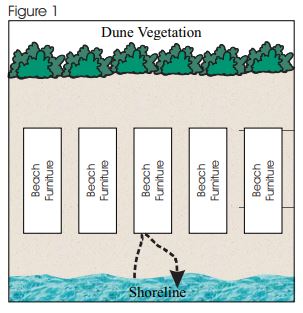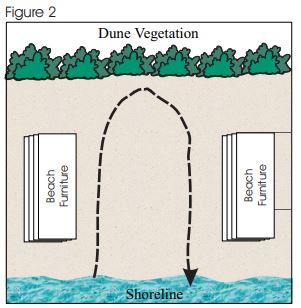Sea turtle populations have been seriously reduced globally through a number of human influences including artificial lighting, plastic and marine debris, beach erosion and coastal armoring, and as bycatch in commercial fishing. Other influences include illegal sea turtle shell trade, oil spills, harvest for consumption, beach activities, and climate change. Natural pressures on sea turtles include predation, both before and after hatching. For these reasons all species of sea turtles are in an imperiled state that warrants legal protection.
Beach furniture can obstruct and entangle nesting sea turtles but there are some simple steps that can be taken to reduce these potential impacts:
visit the Florida Fish and Wildlife Conservation Commission's website.


Figure 1: Placing beach furniture unstacked on the open beach can prevent sea turtles from nesting. Figure 2: Stacking beach furniture and orienting the short end to face the water allows sea turtles to access the beach. Credit: Florida Fish and Wildlife Conservation Commission.
Plastic, Marine Debris, and Balloons
Sea turtles and other marine animals often mistake plastic and other discarded materials for food. Specifically, balloons and plastic bags that are improperly disposed of in the ocean look very much like jellyfish to a feeding sea turtle. It is important that these types of debris are disposed of properly, and that balloons are NEVER released into the air. When balloons are released, they slowly lose their air or pop when they reach a certain altitude, and then fall back down. Wind often carries balloons to bodies of water such as the ocean, where they can be consumed by sea life.
Plastic is becoming more problematic for sea creatures as more of it keeps getting into our oceans. A high percentage of deceased birds and turtles have been found to have plastic in their guts. The ocean gyres that hatchling sea turtles rely on for shelter and food for the first part of their life cycle also gather plastic bottles, bags, rope, and other improperly discarded material. Remember to reduce, reuse, and recycle! Reducing the amount of single-use plastic items you use every day such as straws, eating utensils, and plastic bags is a great way to start!
Predation
Sea turtle eggs and hatchlings are particularly vulnerable to a myriad of natural predators. On Florida’s east coast, eggs are exposed to predators such as raccoons, crabs, ants, spotted skunks, and armadillos; hatchlings are susceptible to predation from foxes, coyotes, crabs, and birds. While predation levels vary among beaches in Florida, Broward County only sees about 10% of nests being impacted in some way by natural predation each year. Humans sometimes unwillingly contribute to this problem by leaving trash or food on nesting beaches, which can attract foxes and raccoons. These animals are also often drawn to populated areas adjacent to the beach by people who deliberately feed them. It is important to remember to never feed wildlife, as it can cause unnatural increases in their populations which leads to them seeking alternative food sources such as sea turtle nests.
Once hatchlings enter the ocean, predation threats remain high since they make convenient “snacks” for birds and fish. However, once in the safety of the seaweed beds, loggerhead turtles are perfectly camouflaged among the floating Sargassum where they can grow and become less susceptible to some predators. As large juveniles and adults, their only natural predators at sea are sharks and toothed whales; tiger sharks have been documented feeding on green sea turtles, while killer whales have been documented feeding on leatherback turtles. Overall, these natural threats are not the predominant reason why sea turtle populations have been diminishing, as they have endured predation for over 100 million years.
